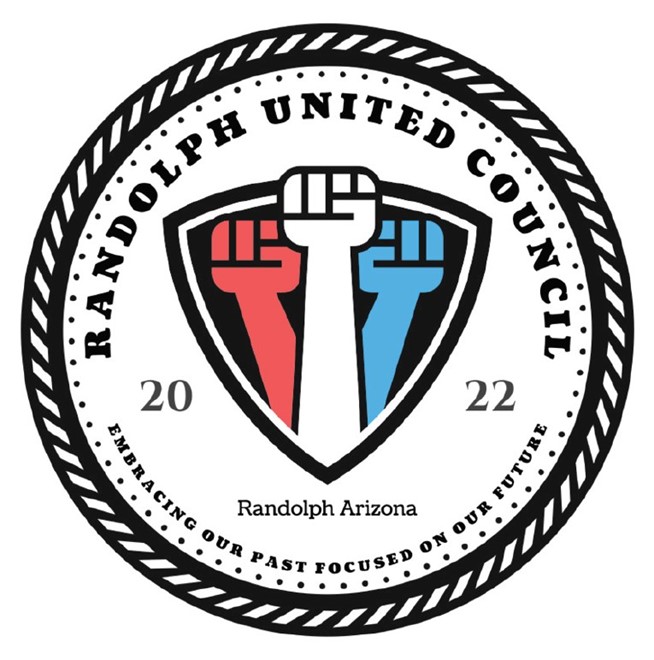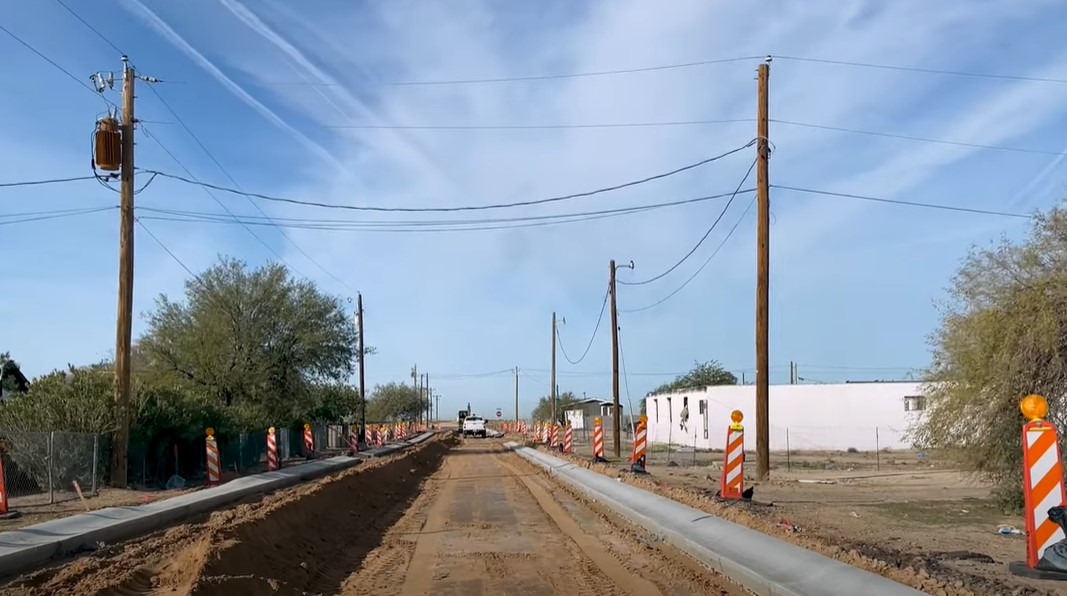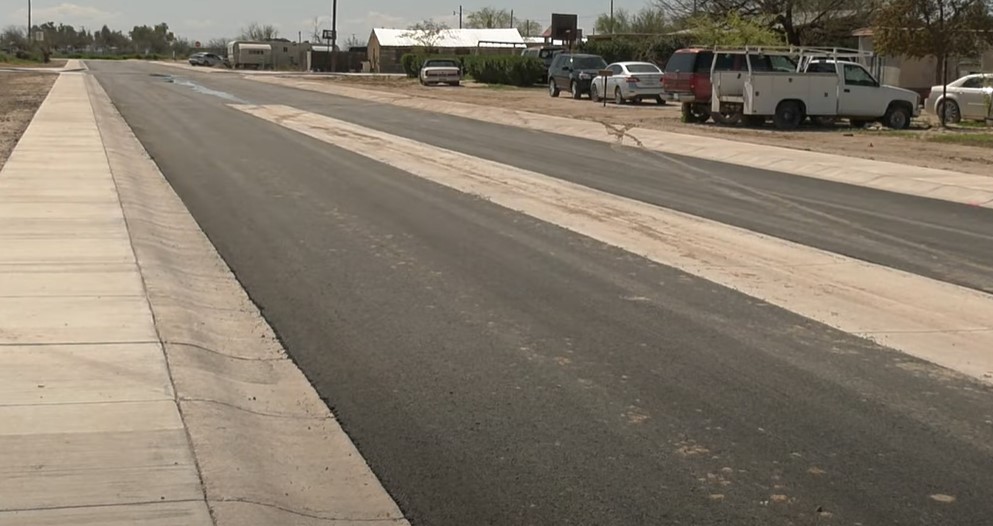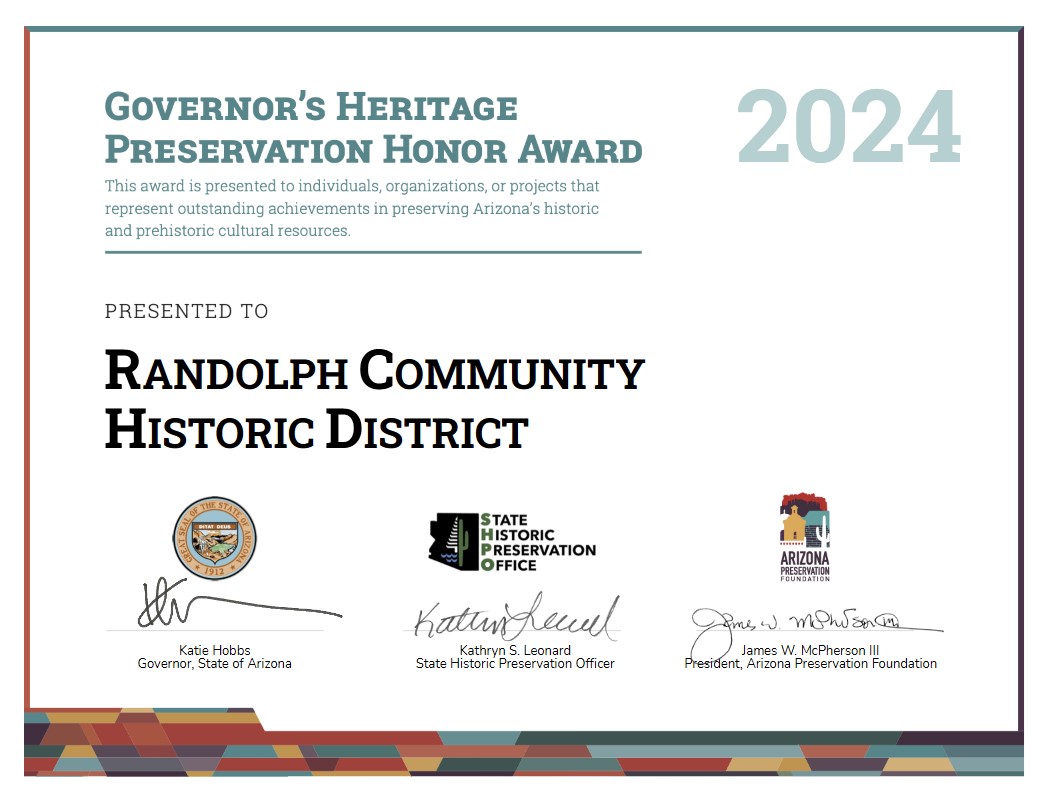
GOVERNOR'S HERITAGEPRESERVATION HONOR AWARD
This award is presented to individuals, organizations, or projects that
See Group Photorepresent outstanding achievements in preserving Arizona's historic
and prehistoric cultural resources.
2024 Arizona Governor's Heritage Preservation Honor Awards Announced
Several members from Randolph United Council (RUC) was in attendance along with RUC Attorney Dianne Post. Some of Council and community members in attendance were: Ronnie Jordan, Dion Rushing, Harvey Rushing, Kyle Muldrow, Mary Turner, Dorothy Wright, Ann Mitchell, Nadine Jordan, Shannon Calloway and Louvina Estelle.
The information below regarding the award was copied from Arizona Preservation Foundation website
The 42nd Annual Governor’s Heritage Preservation Honor Awards, presented by the State Historic Preservation Office and Arizona Preservation Foundation, recognize people, organizations, and projects that represent outstanding achievements in preserving Arizona’s prehistoric and historic resources. Each has significantly contributed to what remains of Arizona’s architectural heritage.
Randolph Community Historic District: A Landmark of Cultural Heritage
The Randolph Community Historic District is a singular example of an extant rural African American community in Arizona. It was recently listed on the National Register of Historic Places as a Traditional Cultural Property. Jennifer Levstik, her staff at Westland, the Community of Randolph, and the Arizona State University Black History Archives collaborated on the preparation of this Historic District nomination. It is the first Black Traditional Cultural Place in Arizona and one of the first of its type in the nation. Community outreach and oral history interviews were a major part of this undertaking. Randolph residents, including Kyle Muldrow, Ronald Jordan, and Angela Acuña; historians Dr. Anthony Pratcher and Dr. Geta LeSuer; and librarians from ASU’s Black Archives played important roles in gathering this information and creating a still growing community archive. The official listing in the National Register gives the community the recognition it deserves as a traditional black community and provides some small level of restorative justice for the years of industrial impacts on the historic rural community.
Several members from Randolph United Council (RUC) was in attendance along with RUC Attorney Dianne Post. Some of Council and community members in attendance were: Ronnie Jordan, Dion Rushing, Harvey Rushing, Kyle Muldrow, Mary Turner, Dorothy Wright, Ann Mitchell, Nadine Jordan, Shannon Calloway and Louvina Estelle.
The information below regarding the award was copied from Arizona Preservation Foundation website
The 42nd Annual Governor’s Heritage Preservation Honor Awards, presented by the State Historic Preservation Office and Arizona Preservation Foundation, recognize people, organizations, and projects that represent outstanding achievements in preserving Arizona’s prehistoric and historic resources. Each has significantly contributed to what remains of Arizona’s architectural heritage.
Randolph Community Historic District: A Landmark of Cultural Heritage
The Randolph Community Historic District is a singular example of an extant rural African American community in Arizona. It was recently listed on the National Register of Historic Places as a Traditional Cultural Property. Jennifer Levstik, her staff at Westland, the Community of Randolph, and the Arizona State University Black History Archives collaborated on the preparation of this Historic District nomination. It is the first Black Traditional Cultural Place in Arizona and one of the first of its type in the nation. Community outreach and oral history interviews were a major part of this undertaking. Randolph residents, including Kyle Muldrow, Ronald Jordan, and Angela Acuña; historians Dr. Anthony Pratcher and Dr. Geta LeSuer; and librarians from ASU’s Black Archives played important roles in gathering this information and creating a still growing community archive. The official listing in the National Register gives the community the recognition it deserves as a traditional black community and provides some small level of restorative justice for the years of industrial impacts on the historic rural community.
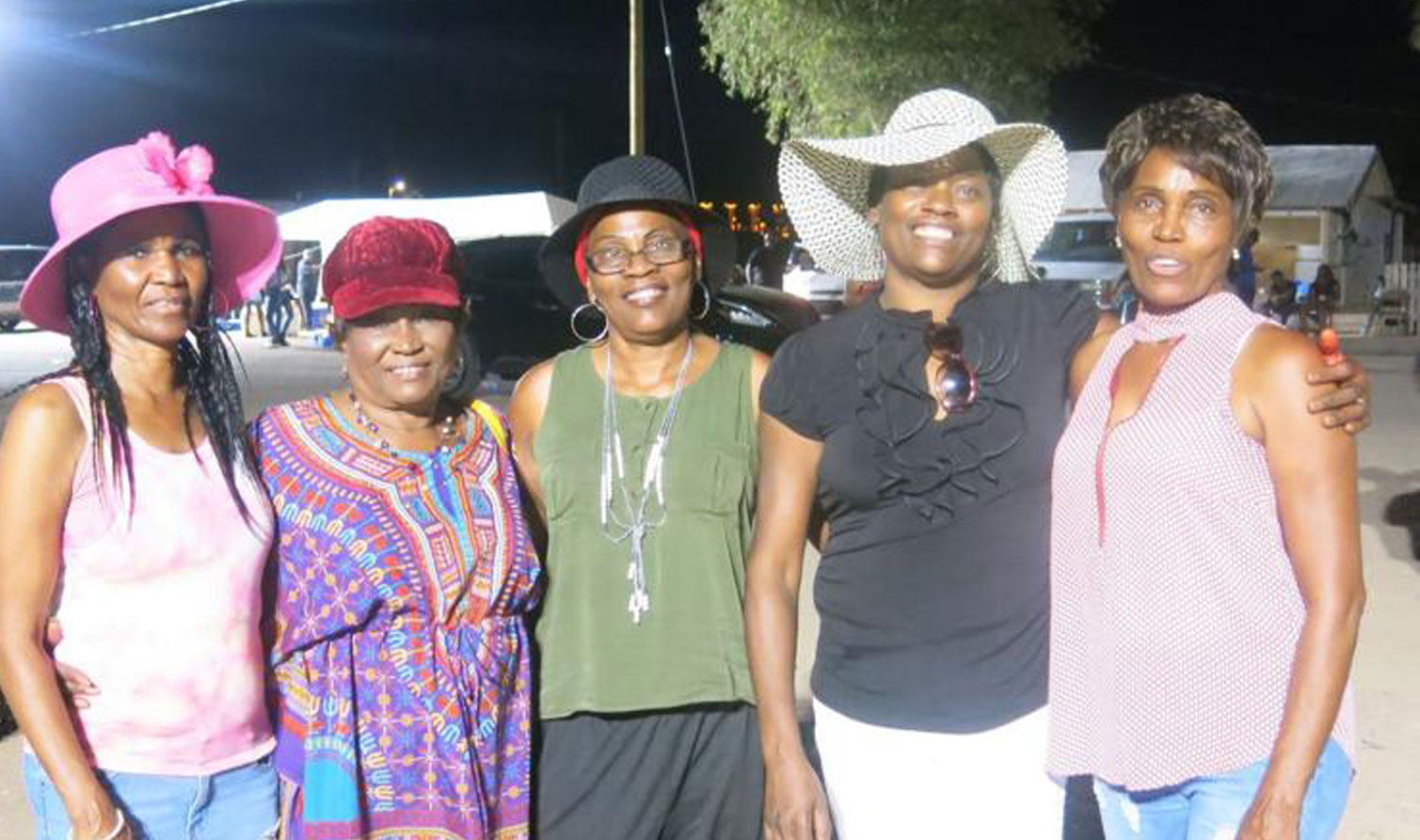
Randolph added to National Register of Historic Places
By ROFIDA KHAIRALLA Staff Writer Apr 24, 2024
RANDOLPH — The community of Randolph is listed on the National Register of Historic Places following a decision announced by the Arizona State Preservation Office.
The listing refers to the community as the Randolph Townsite Historic District and recognizes it as the oldest predominantly African American community in Arizona.
Arizona State Parks and Trails announced the decision in a press release on Wednesday.
Read Full ArticleRANDOLPH — The community of Randolph is listed on the National Register of Historic Places following a decision announced by the Arizona State Preservation Office.
The listing refers to the community as the Randolph Townsite Historic District and recognizes it as the oldest predominantly African American community in Arizona.
Arizona State Parks and Trails announced the decision in a press release on Wednesday.

Randolph residents triumphant as commission rejects SRP expansion
By TAYLOR GRIFFITH Staff Writer Apr 12, 2022 Updated Feb 6, 2024
PHOENIX — Opponents of the Salt River Project Coolidge Expansion Project walked away from the Arizona Corporation Commission chambers with a monumental victory on April 12. But it was not without its trials.
In a decision many from Randolph hoped for but few expected, the ACC voted 4-1 to reject the expansion of the Coolidge Generating Station.
By 10 a.m., Meeting Room One at the ACC building was full of residents who had made the long journey from Randolph and other surrounding areas to Phoenix in order to take a stand against the expansion of the SRP natural gas-operated electric power plant currently located near their small, historically Black community.
The plant expansion in question would more than double emissions, and concerns about the continued degradation of air quality within the town were what led both the residents and the Sierra Club to oppose this project proposal.
Read Full ArticlePHOENIX — Opponents of the Salt River Project Coolidge Expansion Project walked away from the Arizona Corporation Commission chambers with a monumental victory on April 12. But it was not without its trials.
In a decision many from Randolph hoped for but few expected, the ACC voted 4-1 to reject the expansion of the Coolidge Generating Station.
By 10 a.m., Meeting Room One at the ACC building was full of residents who had made the long journey from Randolph and other surrounding areas to Phoenix in order to take a stand against the expansion of the SRP natural gas-operated electric power plant currently located near their small, historically Black community.
The plant expansion in question would more than double emissions, and concerns about the continued degradation of air quality within the town were what led both the residents and the Sierra Club to oppose this project proposal.

The Power of Community: How Randolph, AZ used its History to fight for its Future
In 2021, the Salt River Project (SRP), the largest provider of water and electricity in Central Arizona, made public its proposal to more than double the size of a gas-fired power plant just south of Coolidge. The plant stood next to the small, unincorporated town of Randolph and its expansion would have surrounded the town with industries on three sides. Randolph’s residents, many of whom live near or below the poverty line, organized against the expansion to prevent SRP from significantly increasing the amount of environmentally hazardous products that emanate from their power plants. Remarkably, in the summer of 2022, the Arizona Corporation Commission voted against the expansion. For the town’s residents, it was a “David vs. Goliath” victory -- a stunning moment in the town’s unique history.
Randolph was settled in the 1930s by families who moved west from Texas, Oklahoma and Arkansas to pick cotton in the Gila River Valley. Most of the early settlers were Black and they built a close-knit community based solely around cotton production. By the early 1960s, at the height of the town’s growth, Randolph boasted thriving stores, bars, churches and gas stations. Mechanization of the cotton industry in the 1960s and ‘70s, however, resulted in high unemployment rates and an exodus that sent many to California. When heavily polluting industries arrived to replace cotton production in the 1980s and ‘90s, Randolph and its people struggled not only economically, but environmentally as well. Markers of ill health continue to plague the town. Today, many of Randolph’s residents are descendants of the original families who settled the town and some even live in homes constructed during Randolph’s earliest years. Few places with such a unique history exist in the West today.
Read Full ArticleRandolph was settled in the 1930s by families who moved west from Texas, Oklahoma and Arkansas to pick cotton in the Gila River Valley. Most of the early settlers were Black and they built a close-knit community based solely around cotton production. By the early 1960s, at the height of the town’s growth, Randolph boasted thriving stores, bars, churches and gas stations. Mechanization of the cotton industry in the 1960s and ‘70s, however, resulted in high unemployment rates and an exodus that sent many to California. When heavily polluting industries arrived to replace cotton production in the 1980s and ‘90s, Randolph and its people struggled not only economically, but environmentally as well. Markers of ill health continue to plague the town. Today, many of Randolph’s residents are descendants of the original families who settled the town and some even live in homes constructed during Randolph’s earliest years. Few places with such a unique history exist in the West today.

‘They keep coming back’: a Black community in Arizona battles power expansion plans again
Nina Lakhani in Randolph, Arizona - March 20, 2023
Residents in industry-choked Randolph renew efforts to block the power company’s plans near their fragile town
A handful of weary residents gathered at the windowless Randolph church to mull over the latest effort by an electric utility to expand its power station – a polluting gas-fired plant next door to the community that the state regulator has blocked on environmental and health grounds.
Randolph is a historic Black community in central Arizona flanked by railroads and heavy hazardous industries, a small dusty place where residents are exposed to some of the worst air quality in the state while lacking basic amenities like fire hydrants, trash collection and healthcare.
Last year, the community celebrated a historic win when the state regulator rejected a proposal by the public utility Salt River Project (SRP) to more than double the size of its power plant, ruling that it would cause further harm to Randolph residents and was not in the public interest.
It was major victory for clean energy and environmental justice in Arizona, according to the Sierra Club, the environmental group which condemned the proposed expansion as “textbook environmental racism”.
Read Full ArticleResidents in industry-choked Randolph renew efforts to block the power company’s plans near their fragile town
A handful of weary residents gathered at the windowless Randolph church to mull over the latest effort by an electric utility to expand its power station – a polluting gas-fired plant next door to the community that the state regulator has blocked on environmental and health grounds.
Randolph is a historic Black community in central Arizona flanked by railroads and heavy hazardous industries, a small dusty place where residents are exposed to some of the worst air quality in the state while lacking basic amenities like fire hydrants, trash collection and healthcare.
Last year, the community celebrated a historic win when the state regulator rejected a proposal by the public utility Salt River Project (SRP) to more than double the size of its power plant, ruling that it would cause further harm to Randolph residents and was not in the public interest.
It was major victory for clean energy and environmental justice in Arizona, according to the Sierra Club, the environmental group which condemned the proposed expansion as “textbook environmental racism”.

SRP, Randolph reach settlement on gas-fired plant expansion
By Ron Dungan June 15, 2023
When Salt River Project announced its proposal two years ago to expand a gas-fired generating station, it was met with swift opposition from residents of Randolph, a historic African-American community near Coolidge.
But the two parties have reached a settlement.
Conservationists said the utility should focus on clean energy instead of natural gas.
Randolph residents worried about impacts on the community.
Their opposition got the attention of the Arizona Corporation Commission, which denied SRP’s request for permits.
Under terms of the agreement, the utility will scale back the project and fund scholarships, job training and other programs for local residents.
SRP has filed to reopen its permit request.
Read Full ArticleWhen Salt River Project announced its proposal two years ago to expand a gas-fired generating station, it was met with swift opposition from residents of Randolph, a historic African-American community near Coolidge.
But the two parties have reached a settlement.
Conservationists said the utility should focus on clean energy instead of natural gas.
Randolph residents worried about impacts on the community.
Their opposition got the attention of the Arizona Corporation Commission, which denied SRP’s request for permits.
Under terms of the agreement, the utility will scale back the project and fund scholarships, job training and other programs for local residents.
SRP has filed to reopen its permit request.
Randolph Improvements Update
Dec. 2023
Pinal County Video December 2023
Work is underway to improve the infrastructure of the Randolph community south of Coolidge. Pinal County Development Services, Arizona Water Company, and SRP are all working in conjunction to provide paved streets, fire hydrants, curbing sidewalks, and drainage to the community, which has never had this essential infrastructure.
Work on this project started at the beginning of December 2023 and is scheduled to be done before February 2024.
Watch VideoWork is underway to improve the infrastructure of the Randolph community south of Coolidge. Pinal County Development Services, Arizona Water Company, and SRP are all working in conjunction to provide paved streets, fire hydrants, curbing sidewalks, and drainage to the community, which has never had this essential infrastructure.
Work on this project started at the beginning of December 2023 and is scheduled to be done before February 2024.
Randolph Improvements Update
Mar. 2024
Pinal County Video March 2024
Personnel with Pinal County Development Services and Nesbitt Contracting Co. provide an update in March 2024 to the Randolph Community Revitalization Project.
The goal of this project is to improve the infrastructure of the Randolph community south of Coolidge. Pinal County Development Services, Arizona Water Company, and SRP are all working together to provide paved streets, fire hydrants, curbing, sidewalks, and drainage to the community, which has never had this basic infrastructure.
Work on this project started at the beginning of December 2023 and is scheduled to be done before February 2024.
Watch VideoPersonnel with Pinal County Development Services and Nesbitt Contracting Co. provide an update in March 2024 to the Randolph Community Revitalization Project.
The goal of this project is to improve the infrastructure of the Randolph community south of Coolidge. Pinal County Development Services, Arizona Water Company, and SRP are all working together to provide paved streets, fire hydrants, curbing, sidewalks, and drainage to the community, which has never had this basic infrastructure.
Work on this project started at the beginning of December 2023 and is scheduled to be done before February 2024.
